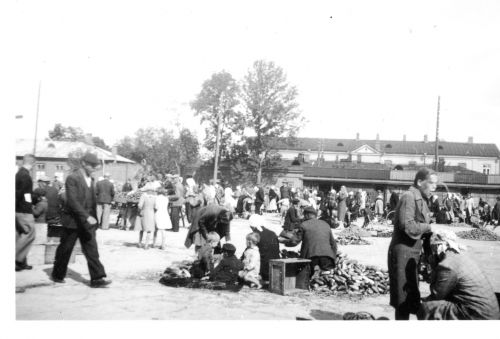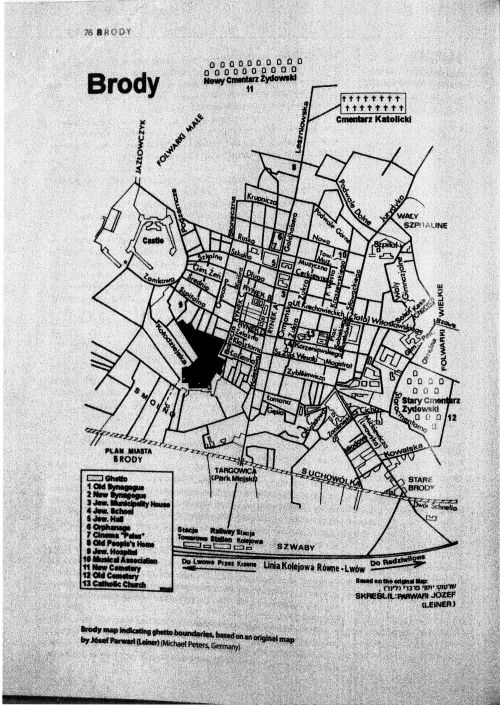Brody

Brody Ghetto Marktplatz (Tall Trees Archives)
Brody is located 54 miles east- north -east of Lwow and in the 19th century, Brody was a major centre of both commercial and cultural activity in the Jewish world, so much that it was known as the 'Amsterdam of the East.' It was home to many rabbis and scholars, as well as Maskilim of Galicia. The Haskalah, or Jewish Enlightenment was an intellectual movement in Europe, that lasted from the 1770's to the 1880's and the the Maskilim were the followers of the Haskalah. The city's Jewish community suffered extensive damage during World War One, but gradually restored itself during the 1920's. Political organisations and affiliations active in Brody included various Zionist parties, as well as Agudath Israel, Polish Jewish integrationists and Communists.In the late 1930's, approximately 8,300 Jews lived in Brody, which represented more than half the city's population, though despite these numbers, they suffered from anti-Semitic discrimination, during this decade.
Brody was occupied by the Soviet Red Army on September 20, 1939. The city's factories and shops were nationalised and the Jewish Community Council was disbanded. In early January 1940, a number of large-scale merchants and Jewish community leaders were exiled into the Russian interior, along with some of the many refugees who had sought refuge in Brody from western Poland during October -November 1939.
After the German invasion of the Soviet Union in June 1941, the Jews, mostly Soviet activists, managed to escape into the Russian interior. The Germans occupied Brody on June 29, 1941, immediately afterwards on July 1-2, the Germans arrested approximately forty Jewish public figures whom they accused of Soviet activity. On July 12, 1941, Gestapo forces under the command of Hermann Mueller murdered between 200 and 250 Jews belonging to the intelligentsia, who had been called in two days earlier for a meeting with the authorities representatives. A few days later, Einsatzkommando 5, under the command of Erwin Schulz, murdered Jewish Prisoners of War, along with some 300 Jews who had been arrested in the city and its environs. On July 15, 1941, severe restrictions were imposed on the Jews freedom of movement : they were ordered to wear 'Star of David' armbands, and many were rounded up to perform forced labour tasks.

Brody - Map of the Ghetto
From August 1941, a German civil administration assumed responsibility for governing Brody, which became part of the Kreis Zloczow, within the so-called Distrikt Galizien. Initially the Kreishauptmann was Gerichts-Assessor Hans Mann, but in January 1942, Dr. Otto Wendt succeeded him. The Kreis was divided into several sub-districts, known as Landkommissariate. Fritz Weiss was in charge of the Brody Landkommissariat.
The anti-Jewish 'Aktionen' in Brody were carried out under the direction of the office of the Security Police and SD based in Lwow, the KdS Lemberg, assisted also by staff from the office of the Kripo (Criminal Police) in Zloczow, directed by a police officer originally from Vienna, Otto Zikmunt. There was also a local office of the Kripo in Brody, which received its orders from the Kripo office in Zloczow. In addition, in Brody, there was also an office of the German Gendarmerie, which supervised the local Ukrainian Auxiliary Police, headed by Stepan Syhovich. The Gendarmerie and the Ukrainian police played an active role in the anti-Jewish 'Aktionen.'
In the second half of July 1941, the German authorities established a Jewish Council (Judenrat), headed by Dr. Jakow Blech. Jews were ordered to wear white armbands bearing a Star of David; most of their property was confiscated, and they were stripped of many basic rights. The Jews were required to register for forced labour for very low wages and also had to pay a mandatory fee of 750 rubles each to the main bank in Brody by August 5, 1941. Those who failed to comply with these demands, faced severe punishment.
In October 1941, Jews from the surrounding areas were ordered to move to Brody. Some Jews from Brody were also forced to go to Zloczow for work. On October 19, 1941, several groups of young Jewish males who were physically fit for hard work were sent to the Kozaki Labour Camp. On December 27, 1941, several larger groups were sent to labour camps, from which, no one usually returned. These camps were located in Lackie Wielke, Jaktorow, Pluhow and Zborow. In January 1942, the German authorities established an open ghetto in Brody. At the same time, Jews in Brody were ordered to surrender their winter clothing, including any fur coats and winter shoes.
In June 1942, a number of Jews reportedly were living in the following villages around Brody:
Toporow - 734
Leszniow - 321
Sokolowka - 269
Koniuszkow - 236
Suchowola - 452
Stanislawczyk - 626
On September 19, 1942, the Germans deported 2,500 Jews from Brody to the Belzec death camp. The deportation 'Aktion' was conducted by the German police aided by Ukrainian Police and members of the Jewish Order Service. They rounded Jews up in the market place. Approximately 300 Jews lost their lives in the round-up. A second 'Aktion' was carried out on November 2, 1942, where 3,000 Jews were deported to the Belzec death camp, and the head of the Judenrat was also murdered.
The outpost of the Security Police (Sipo - Aussenstelle) in Sokal, under the command of SS-Officer Oswald Heyduk organised the first deportation 'Aktion.' The second 'Aktion' was conducted by forces under the command of SS Officer Carl Wobke, of the outpost's Jewish section, assisted by the Ukrainian Auxiliary Police.
On December 2, 1942, approximately 2,000 more Jews were brought into the ghetto from various villages, including Toporow, Stanislawczyk and others. At this time, in accordance with the order of Friedrich- Wilhem Kruger, the Higher SS and Police Leader East for the Generalgouvernement, that an enclosed ghetto should be established in Brody. The ghetto was located around Shlitelnaia Street, where most of the Jews already lived. The Ghetto was surrounded with barbed wire, with only a single entrance. German and Ukrainian police guarded the ghetto and placards were placed which declared that anyone attempting to leave would be shot. The living conditions in the ghetto were appalling, often as many as 25 or 30 people lived in one room.
Those Jews who received special work passes because they were working for the Wehrmacht (W) or for the armaments industry, Rustungsindustrie (R) , however, were put into small labour camps, consisting mostly of enclosed barracks located at the factories, some inside and some outside the ghetto. The total number of people in the ghetto increased to more than 5,000. During the winter of 1942 - 1943, approximately 1,000 people died from starvation, sickness and disease, especially from typhus.
On May 21, 1943, the SSPF for the Distrikt Galizien, Friedrich Katzmann, issued orders for the liquidation of the Brody ghetto, which resulted in the immediate shooting of 100 Jews and numerous deportations to Lublin Concentration Camp. Some Jews offered armed resistance, killing four Ukrainians and several German policemen. These acts of rebellion provoked the German forces into treating the remaining Jews even more brutally. They burned down some of the houses to force those Jews in hiding, to come out. The liquidation of the ghetto took about one month, lasting well into June 1943. Two months after the liquidation of the Brody ghetto, there still remained approximately 40 Jews working in the city. However, they were murdered on July 19, 1943.
Looking back on the history of Jewish resistance in Brody, at the end of 1942, a Jewish resistance organisation was secretly formed in the Brody ghetto. The leaders of the group were Jakow Linder and Shmuel Weiler. They managed to develop contacts with the Jewish underground organisation in the Lemberg (Lwow) ghetto, as well as with members of the secret Communist Party group called, Narodnaia Gvardia imeni Ivana Franka, which was also based in Lemberg. Their primary goal was to establish an independent partisan force, which would have three bases operating clandestinely throughout the Lwow region to resist the murder of Jews.
In April 1943, approximately 70 Jews managed to escape from the ghettos. Linder's group organised a number of attacks on ghettos, forced Labour Camps, and other targets, which were only lightly protected. Among the successful attacks were those on the fuel factory in Sokolowka and against the Labour Camp in Sasow. As a result of the above- mentioned raids to liberate Jewish prisoners, the strength of the resistance was augmented. The partisans were also active in blowing up bridges used by German forces. As a result of the interrogations of some captured partisans, the Germans acquired more detailed information about the groups operating in the forests near Brody. Consequently German soldiers and Ukrainian police searched the area and launched a number of raids, which resulted in the killing of 33 Jewish partisans.
One group of Jews in Brody managed to escape the liquidation operations by hiding in the ruins of the old synagogue. However, the local police reported their presence to the German authorities. The German commander, Meister der Gendarmerie Damm, ordered the arrest of the Jews. Of the 12 Jews hiding there, 6 were captured and killed by the German Security Police and their Ukrainian helpers.
At the time of liberation in July 1944, several hundred Jews returned to the city, having survived with the partisans in the surrounding forests, or in hiding outside the ghetto.
After the war, Otto Wendt was a secretary in the Ministry of Economics in Lower Saxony. In 1969, without bringing charges, the West German authorities abandoned their investigation into his alleged involvement in the persecution of Jews. Otto Zikmunt was extradited to the Soviet Union in 1949. He was subsequently convicted by a Soviet Court and died in prison. S.I. Syhovich, who headed the Ukrainian Auxiliary Police in Brody, was sentenced to death by a Soviet Military Tribunal and executed in 1944.
Sources
Encyclopaedia of Camps and Ghettos 1933- 1945, USHMM, Indianna University Press Bloomington and Indianapolis 2012
Encyclopaedia of the Holocaust, published by Macmillan Publishing Company, New York, 1990
Photograph - Tall Trees Archive
© Holocaust Historical Society 2019

